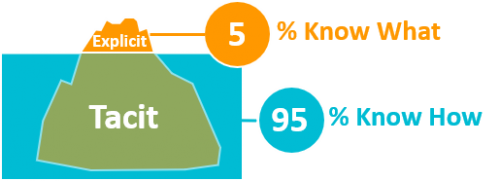Unlocking the true potential of your human capital, demands a solution that goes beyond training. A complete Learning Solution facilitated by training but enriched with communication and on the job practice, moves a knowledgeable workforce to an experienced one. When an individual processes something, there’s no guarantee that the interpretation they receive is sufficient. And to effectively address that takes either interaction with other learners or an expert during synchronous learning.

A survey in The Career Architect Development Planner (McCall, Lombardo and Eichinger) revealed that: Lessons learned by successful and effective managers are:

The numbers are historical artifacts, and the true value of the model is that it extends learning beyond the classroom by implementing workplace and social learning. In the reality of today we rather call this blended learning with Formal-Informal-Social, or as Dan Pontefract defines it: the 3×33 ‘Pervasive Learning’.
This also aligns with the SECI model that describes how explicit and tacit knowledge is generated, transferred, and recreated in organizations. By Nonaka and Takeuchi, 1995.

During day to day life we encounter new challenges that unveil our unconscious incompetence. Seeking help from others that can demonstrate a successful resolution (Socialization) will make us conscious about our incompetence. If the challenge keeps on appearing a more sustainable solution in the form of formal learning (Externalization & Combination) will be needed so we become conscious competent. At a certain moment the item that appeared to be a challenge gets integrated in our daily routine (Internalization) as it has become unconscious competence. During these phases we move skills and knowledge from tacit to tacit, tacit to explicit, explicit to explicit, explicit to tacit.
To build a perfect blend that supports this model a proper micro-learning distribution and creation strategy will be needed:
- During socialization use the expertise from the unconscious competent (SME), to guide the conscious incompetent. This will allow you withe help of the SME to record tacit knowledge into several micro learning blocks.
- During externalization and combination, you will need to strengthen the tacit-tacit learning, this by revisiting the tacit knowledge with the recorded micro learning blocks that are enhanced with a formative assessment.
- Encourage the newly conscious competent to contribute new micro learning blocks that can be used during socialization, externalization and combination.
Captivate Prime and Captivate are great tools that will allow you and the unconscious competent (SME) to create the micro learning blocks that and the formative assessments.
Unlocking the true potential of your human capital, demands a solution that goes beyond training. A complete Learning Solution facilitated by training but enriched with communication and on the job practice, moves a knowledgeable workforce to an experienced one. When an individual processes something, there’s no guarantee that the interpretation they receive is sufficient. And to effectively address that takes either interaction with other learners or an expert during synchronous learning.

A survey in The Career Architect Development Planner (McCall, Lombardo and Eichinger) revealed that: Lessons learned by successful and effective managers are:

The numbers are historical artifacts, and the true value of the model is that it extends learning beyond the classroom by implementing workplace and social learning. In the reality of today we rather call this blended learning with Formal-Informal-Social, or as Dan Pontefract defines it: the 3×33 ‘Pervasive Learning’.
This also aligns with the SECI model that describes how explicit and tacit knowledge is generated, transferred, and recreated in organizations. By Nonaka and Takeuchi, 1995.

During day to day life we encounter new challenges that unveil our unconscious incompetence. Seeking help from others that can demonstrate a successful resolution (Socialization) will make us conscious about our incompetence. If the challenge keeps on appearing a more sustainable solution in the form of formal learning (Externalization & Combination) will be needed so we become conscious competent. At a certain moment the item that appeared to be a challenge gets integrated in our daily routine (Internalization) as it has become unconscious competence. During these phases we move skills and knowledge from tacit to tacit, tacit to explicit, explicit to explicit, explicit to tacit.
To build a perfect blend that supports this model a proper micro-learning distribution and creation strategy will be needed:
- During socialization use the expertise from the unconscious competent (SME), to guide the conscious incompetent. This will allow you withe help of the SME to record tacit knowledge into several micro learning blocks.
- During externalization and combination, you will need to strengthen the tacit-tacit learning, this by revisiting the tacit knowledge with the recorded micro learning blocks that are enhanced with a formative assessment.
- Encourage the newly conscious competent to contribute new micro learning blocks that can be used during socialization, externalization and combination.
Captivate Prime and Captivate are great tools that will allow you and the unconscious competent (SME) to create the micro learning blocks that and the formative assessments.
You must be logged in to post a comment.
- Most Recent
- Most Relevant
Hi Todd, Tacit knowledge is a reality that we forget. These are all the undocumented skills , that are socialized by the SME over and over again. This type of learning is never accounted for and is a hidden loss of productiont value for an organization. With the intervention of L&D this type of social learning can be recorded and actually relieve the SME from being overwhelmed.






